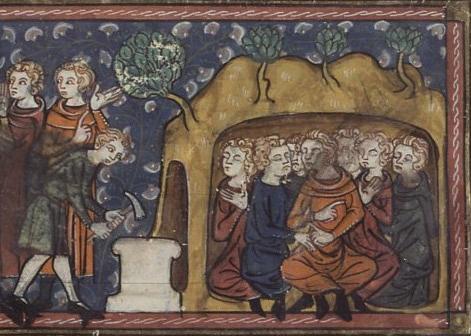
Illuminated manuscript from the 14th century shows the seven sleepers being walled into the cave.
In Christian and Islamic tradition, the Seven Sleepers of Ephesus is the story of a group of seven youths who hid inside a cave outside the city of Ephesus around 250 AD to escape a religious persecution. The fell asleep and came out of the cave 300 years later.
The story says that during the persecutions by the Roman emperor Decius, around 250 AD, seven young men were accused of following Christianity. They were given some time to recant their faith, but chose instead to give their worldly goods to the poor and retire to a mountain cave to pray, where they fell asleep. The emperor, Decius, ordered the mouth of the cave to be sealed.
Decius died in 251, and many years passed during which Christianity went from being persecuted to being the state religion of the Roman Empire. At some later time – usually given as during the reign of Theodosius II (408–450) – the landowner decided to open up the sealed mouth of the cave, thinking to use it as a cattle pen. He opened it and found the sleepers inside. They awoke, imagining that they had slept but one day, and sent one of their number to Ephesus to buy food, with instructions to be careful lest the pagans recognize and seize him.
Upon arriving in the city, this person was astounded to find buildings with crosses attached; the townspeople for their part were astounded to find a man trying to spend old coins from the reign of Decius. The bishop was summoned to interview the sleepers; they told him their miracle story, and died praising God.
The survival of the Seven Sleepers in the cave was taken as proof of the possibility of the general resurrection of the dead, which some were denying in the fifth century. The Seven Sleepers were invoked by people suffering terrible nightmares. Their aid was also sought by people suffering insomnia or who could not sleep because of great pain or other illness.
The story appears in Christian collections of saints’ lives and in the Qur’an (Surah Al-Kahf, verse 9–26) and is thus important to Islam. The Quranic story does not state the exact number of sleepers, but gives the number of years that they slept as 300 solar years (equivalent to 309 lunar years). The Islamic version includes mention of a dog who accompanied the youths into the cave and appears to keep watch. In Islam, these youths are referred to as “The People of the Cave”.
The flag of Kelantan in the 19th century, located in present-day Malaysia, incorporated elements from the Islamic interpretation of the story. In the surah, the dog is believed to act as a guardian, looking out for the believers until they awake.
See more icons of the Seven Sleepers here.

Very interesting Stephen! I had never heard of the Seven Sleepers before! Thanks for sharing. Liked the icon link also.
John: Glad to have introduced you to the Seven Sleepers! I have always liked them… there’s something about the alliteration of the Seven SleeperS of EpheSuS that grabs my attention and makes me smile. I was hoping people would appreciate the icon link as well.